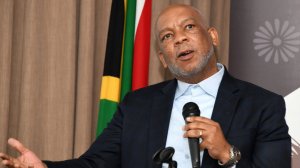Ramokgopa describes IPP surpluses as low-hanging fruit amid delay in finding contractual solution
Electricity Minister Kgosientsho Ramokgopa describes surplus electricity arising from existing renewable energy facilities as “low hanging fruit” in improving the supply-demand balance and reports that discussions are under way to assess ways to make this energy available to the grid.
Speaking during a regular update on the Energy Action Plan, Ramokgopa confirmed that the issue, which had been under consideration for years, had again been raised with him by the leadership of Scatec during his recent visit to the group’s Kenhardt solar-battery facility in the Northern Cape.
The hybrid Kenhardt plant comprises 540 MW of solar photovoltaic capacity and 225 MW/1.1 GWh of battery storage to provide 150 MW of dispatchable electricity daily.
However, it is restricted, owing to the design of the much-criticised risk-mitigation procurement programme, from delivering any surplus solar electricity into the grid.
It is understood that this results in up to 30% of the plant’s solar generation being lost to the system. This despite the threat of daily loadshedding, which has eased somewhat in recent weeks, with Eskom having refrained from implementing rotational cuts for 26 days at the time of the briefing.
Ramokgopa said finding a way to absorb the surplus being generated by Kenhardt and other renewables independent power producers (IPPs) required a “three-way conversation” between Eskom, the IPPs and government’s IPP Office regarding a fair contractual model.
It would also be feasible, he added, only if there was sufficient grid capacity to absorb the electricity.
That said, discussions regarding the surplus available from existing IPPs have been under way for years, and even predate the 2022 establishment of the National Energy Crisis Committee, which initially indicated there to be some 70 MW of such surplus capacity available, which was before Kenhardt entered commercial operations.
It is not clear why the negotiations have not progressed, with Ramokgopa indicating that several IPPs had approached him directly about the surplus that they “essentially throw away” because it exceeded their contractual limits.
“We have initiated discussions with Eskom and the IPP Office to see how best we can design an intervention that makes it possible for us to benefit from that excess generation, without undermining what was a public procurement process to contract the megawatts,” the Minister said.
The outcome, he added, should not lead to questions about the credibility of the procurement processes or the resulting contracts, as the business case of the IPPs would be improved should the surplus electricity above the initial contracted amount be purchased.
“It’s a conversation we are having and the sooner we resolve it the better, [because] this is one of the matters I refer to as a low-hanging fruit.”
DIESEL USE FALLING
Meanwhile, Ramokgopa expressed confidence that the loadshedding corner had been turned, which he attributed to more stable production from the coal fleet and the relief on the system being provided by both large-scale renewables and surging rooftop solar installations.
Last year about 2 500 MW of rooftop solar was added, much of which was coupled to battery storage, increasing the overall installed base to above 5 000 MW.
The installations had decreased daytime demand, which provided space for the replenishment of pumped storage reserves.
The combination of improved coal stability, renewables, batteries and lower demand meant that Eskom was expecting to operate the open cycle gas turbines (OCGTs) it owned, as well as those operated by IPPs, at a far reduced capacity factor than was the case in its 2023/24 financial year.
The utility confirmed that it exceeded its R30-billion diesel budget for the period by R3-billion.
Ramokgopa said that, since December, Eskom had been using OCGTs less than the 17% average that had been the case for the financial year as a whole, with load factors ranging from 6% in December to 17% in March.
He said that for the April month-to-date, the average load factor had been 5.97%.
Eskom would provide its winter outlook on April 26, where it would provide three loadshedding scenarios for the period to the end of August, including a base case whereby unplanned breakdowns were kept below 14 000 MW and planned maintenance at about 3 500 MW.
Under such a scenario only limited loadshedding was expected, which would rise, however, if breakdowns breached the 14 000 MW level.
Comments
Press Office
Announcements
What's On
Subscribe to improve your user experience...
Option 1 (equivalent of R125 a month):
Receive a weekly copy of Creamer Media's Engineering News & Mining Weekly magazine
(print copy for those in South Africa and e-magazine for those outside of South Africa)
Receive daily email newsletters
Access to full search results
Access archive of magazine back copies
Access to Projects in Progress
Access to ONE Research Report of your choice in PDF format
Option 2 (equivalent of R375 a month):
All benefits from Option 1
PLUS
Access to Creamer Media's Research Channel Africa for ALL Research Reports, in PDF format, on various industrial and mining sectors
including Electricity; Water; Energy Transition; Hydrogen; Roads, Rail and Ports; Coal; Gold; Platinum; Battery Metals; etc.
Already a subscriber?
Forgotten your password?
Receive weekly copy of Creamer Media's Engineering News & Mining Weekly magazine (print copy for those in South Africa and e-magazine for those outside of South Africa)
➕
Recieve daily email newsletters
➕
Access to full search results
➕
Access archive of magazine back copies
➕
Access to Projects in Progress
➕
Access to ONE Research Report of your choice in PDF format
RESEARCH CHANNEL AFRICA
R4500 (equivalent of R375 a month)
SUBSCRIBEAll benefits from Option 1
➕
Access to Creamer Media's Research Channel Africa for ALL Research Reports on various industrial and mining sectors, in PDF format, including on:
Electricity
➕
Water
➕
Energy Transition
➕
Hydrogen
➕
Roads, Rail and Ports
➕
Coal
➕
Gold
➕
Platinum
➕
Battery Metals
➕
etc.
Receive all benefits from Option 1 or Option 2 delivered to numerous people at your company
➕
Multiple User names and Passwords for simultaneous log-ins
➕
Intranet integration access to all in your organisation





















